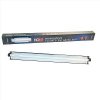Planet Tomato
Member
Hello.
I am putting together a LED grow light, as it stands now it is planned like this:

[The picture is dimensionally accurate, while using 25mm for the EBgen2 width and 3cm diameter for the 3W LED's which are star boards]
The stated 15min before and after sunrise/sunset isn't a sure thing, I will be experimenting to see how short time I need to trigger flowering.
I have 2 * 60cm T5 fixtures(they are actually 57,5cm total length not including the power connector which sticks out a couple of cm if I don't make a custom plug of some sort which I will do) that look like this:

They will probably stick out slightly outside the aluminium sheet that will be used to mount everything onto.
But the reflector are 6cm wide which makes this very difficult to use in a good way on the panel to be built as the above diagram showed, I am also worried about the reflector in that T5 fixture, why would I think that the plastic material in that reflector is any good for reflecting UV light?
While reading about Solacure's products I read that there tubes have an internal reflector to direct the light in one direction, I have also read that aluminium foil is a surprisingly good reflector for UV, if so might I take some aluminium foil and glue it onto the T5 reptile tube to cover 40-50% of the outside circumference of the tube in order to reflect the light downwards towards the plant(s)?
If people where to think or agree that to be a valid way to reflect the UV light then I could simply remove the reflector from my T5 fixtures which would make them only 2,4cm wide which would make it very easy to fit them onto the grow light panel. In that case I might reduce the design to only 2 rows of 3W LED's and eliminate the 3W UVA LED's since I am going to use these reptile lamps which features 14% UVB and 30% UVA.
I'm not entirely sure that I have covered everything I intended to or need to in order to allow people can give advice but anyway(am I alone in being severely confused 24/7 regarding every aspect of life...?).
Any and all inputs are greatly appreciated.
Regards
I am putting together a LED grow light, as it stands now it is planned like this:

[The picture is dimensionally accurate, while using 25mm for the EBgen2 width and 3cm diameter for the 3W LED's which are star boards]
The stated 15min before and after sunrise/sunset isn't a sure thing, I will be experimenting to see how short time I need to trigger flowering.
I have 2 * 60cm T5 fixtures(they are actually 57,5cm total length not including the power connector which sticks out a couple of cm if I don't make a custom plug of some sort which I will do) that look like this:

They will probably stick out slightly outside the aluminium sheet that will be used to mount everything onto.
But the reflector are 6cm wide which makes this very difficult to use in a good way on the panel to be built as the above diagram showed, I am also worried about the reflector in that T5 fixture, why would I think that the plastic material in that reflector is any good for reflecting UV light?
While reading about Solacure's products I read that there tubes have an internal reflector to direct the light in one direction, I have also read that aluminium foil is a surprisingly good reflector for UV, if so might I take some aluminium foil and glue it onto the T5 reptile tube to cover 40-50% of the outside circumference of the tube in order to reflect the light downwards towards the plant(s)?
If people where to think or agree that to be a valid way to reflect the UV light then I could simply remove the reflector from my T5 fixtures which would make them only 2,4cm wide which would make it very easy to fit them onto the grow light panel. In that case I might reduce the design to only 2 rows of 3W LED's and eliminate the 3W UVA LED's since I am going to use these reptile lamps which features 14% UVB and 30% UVA.
I'm not entirely sure that I have covered everything I intended to or need to in order to allow people can give advice but anyway(am I alone in being severely confused 24/7 regarding every aspect of life...?).
Any and all inputs are greatly appreciated.
Regards



